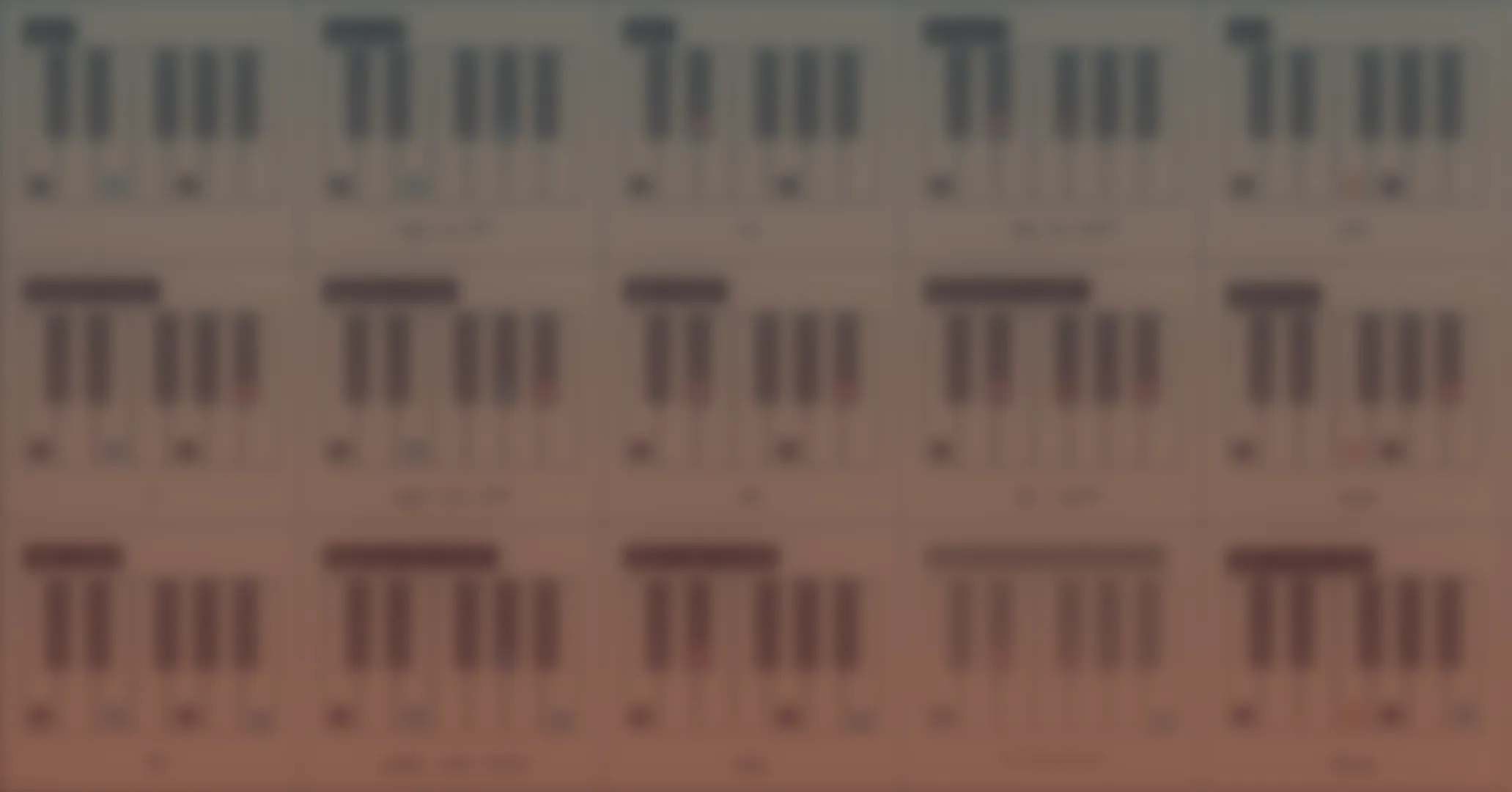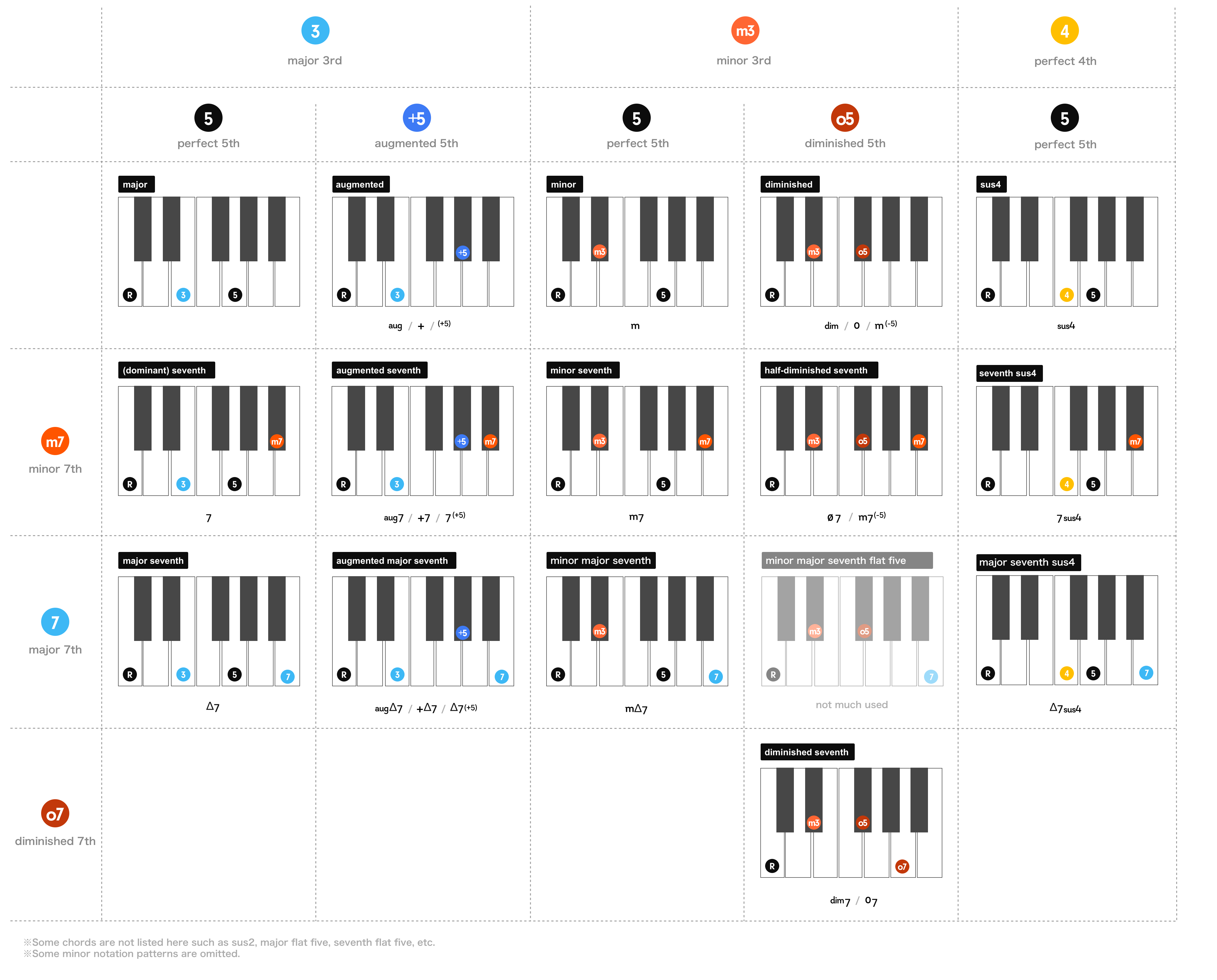Contents
3. Further Symbolization
Each chord was given a nickname based on “aug” and “dim.” However, writing or printing small “aug” or “dim” in scores or texts might have been tedious and technically challenging. The theorists provided them with simple symbols — “plus” and “circle.”
This is more aesthetically pleasing and symbolic than three alphabetic characters. But, while the plus is fine, the circle might be hard to imagine its meaning, unlike the direct association of “aug” and “dim” with English words. These kinds of notations were already observed in the 19th century. Perhaps this was due to the constraints of printing technology in those times that led to such symbolization.
 Stephen A. Emery “Elements of Harmony” p.12 (1879)
Stephen A. Emery “Elements of Harmony” p.12 (1879)If “aug” is a plus, I wanted “dim” to be a minus…… But surely, precision issues with printing or ink could have been a factor… Upon closer inspection of this literature, the circle resembles more of a mathematical “zero exponent” than a simple circle. This reflects the era without computers, choosing symbols that could somehow be printed and managed.
Plus and Circle for Seventh Chords
This plus/circle system naturally applies to seventh chords. Moreover, for the earlier mentioned “Half-Diminished”, a symbol like bisected circle is used.
The symbol for half-diminished is expressed as “ø” (slashed o) or “φ” (phi) on a computer. Also, for the diminished circle, it may be “o” (lowercase letter o) or “º” (degree symbol). Some also use “O” (capital letter O) as a superscript.
Simplification and Confusion
Furthermore, the trio of “Δ, o, ø” can also be written without including the “7”.
This omission of “7” likely evolved in the jazz world where the notion of “Seventh chords are always the standard form” made it unnecessary to explicitly write the 7. It’s an idea never found in the classical theory. While not a universally adopted notation, this “omission of 7” is potentially used in jazz scores without specific indication. The confusion deepens…
Additionally, concerning “dim,” not only the circle symbol but also the symbol “dim” may indicate diminished seventh.
Diminished… Triads or Tetrads?
Here, a clear confusion arises – Depending on the person, it varies whether the chord symbols “dim” or “o” refer to triads or tetrads.
Classical schools tend towards triads, while jazz schools lean towards tetrads, but this is merely a tendency. Regarding this aspect, it becomes essential to be mindful in communication with others🥺
Clear Notation to Avoid Misunderstanding
If you want to minimize miscommunication, using “minor flat-fifth” for the triad and “diminished seventh” for the tetrad will undoubtedly convey your intention.
However, if the other person uses the notation “dim,” careful consideration is still required.
4. Summary of Notations
Now that we’ve covered all the variations in symbols, let’s summarize them in a table. “no symbol” for major and “7” for dominant seventh are universally common notations across any schools so I’ll focus on the rest.
| Type | min | aug | dim | M7 | m7 | mM7 | dim7 | m7(-5) | 7(+5) |
|---|---|---|---|---|---|---|---|---|---|
| (1) Basic | m | (♯5) | m(♭5) | M7 | m7 | mM7 | dim7 | m7(♭5) | 7(♯5) |
| (2) +/- | “ | (+5) | m(-5) | “ | “ | “ | “ | m7(-5) | 7(+5) |
| (3) aug/dim | “ | aug | dim | “ | “ | “ | “ | m7(-5) | aug7 |
| (4) Symbolic | – | + | o | Δ7 | -7 | -Δ7 | o7 | ø7 | +7 |
| (5) Without 7 | “ | “ | m(♭5) | Δ | “ | -Δ | o | ø | “ |
Of course, there are cases where these notations are used in mix. On this site, for example, the symbol for major seventh is “Δ”, but for minor, we use “m” instead of “-” due to readability concerns.
There’s no indication that any particular notation is exceptionally dominant; in in-depth jazz theory books, there is a tendency toward notation similar to (4), while lighter popular theory books often favor simpler notations like (1). However, it really depends on the person.
In the introduction, I explained that music theory is a tool for verbalizing sounds. Indeed, because it is a language, many “dialects” have emerged. This is unavoidable. Rather, considering the span of several hundred years and the multitude of countries traversed, it’s remarkable that the variations are relatively contained! Let’s view it positively \\٩( ‘ω’ )و //
Notation on This Site
As a basic policy on this site, the following notations are used:
| min | aug | dim | M7 | m7 | mM7 | dim7 | m7(-5) |
|---|---|---|---|---|---|---|---|
| m | + | m(-5) | Δ7 | m7 | mΔ7 | o7 | ø7 |
Overall, there’s a higher use of symbols, prioritizing readability and conciseness.
The assessment of which notation is great can change based on what is prioritized, be it logical consistency, ease of writing, or readability. It’s advisable not to be overly fixated on judging superiority/inferiority.
5. Keyboard Overview
While we summarized on the music sheet earlier, navigating the complexities of intervals might be more intuitive on the keyboard. Let’s create a chord chart for easy reference.
Some of the miscellaneous chords like sus2 or major flat-fifth are omitted here.
The vertical and horizontal grids are crucial, and the elements are not that numerous after all. As mentioned before, it is essential to recognize that chord names are born from these combinations.
Remember again that rote memorization is not an effective way of learning. What actually matters is its practical usage – Useful roots for each chord type and the musical effect they bring. And acquiring knowledge gradually through practice ensures it becomes real “wisdom”.
Summary
- Transformed Chords have been given various notations and names throughout history.
- aug is represented by “+”, dim by “o”, and minor seventh flat fifth by “ø”.
- Be cautious of the notation with or without the omission of “7” as it may lead to miscommunication.
- Each notation has its advantages and disadvantages, so use the one that suits your preference.


